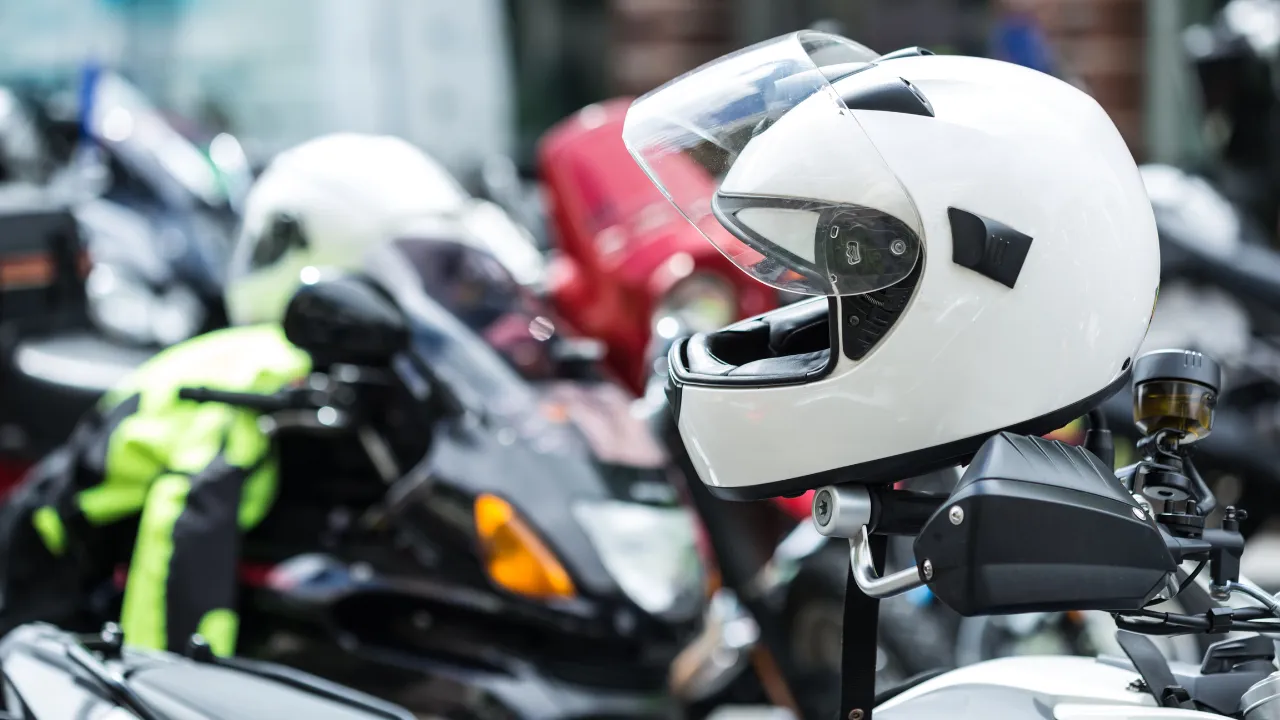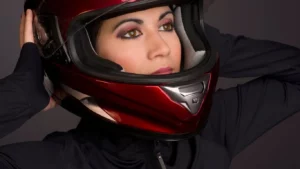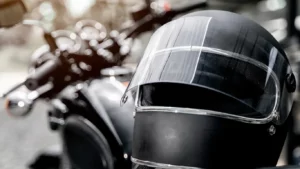The helmet is the most significant piece of safety gear to protect you from head trauma or injuries. You might have seen many riders die due to severe head injuries. I also faced accidents, but helmets protected me from such hazardous issues.
In this essay, I will discuss the Helmet Size as well as its appearance. In addition, I will explain how to choose the helmet size that is most appropriate for you.
Your helmet should be the right size for you, as a larger one might not offer sufficient protection in some situations. You need to have an accurate understanding of the ideal dimensions, weight, and shape for the task at hand.
Why Does Your Bike Helmet Look Big?
The large size of the helmet was chosen for a number of reasons, all of which are going to be explained in detail below for your understanding.
Sometimes, certain helmet manufacturers construct the Helmet itself in such a way that in the event of a bike accident or some other severe accident, the Helmet is built to protect a person’s head by layering several different layers.
Because of this, the motorcycle helmet has an imposingly large appearance.
The second possibility is that your head is very large. To protect you from head injuries and other hazards, some manufacturers create helmets that are double the size of a typical person’s head.
Because of this, your enormous head appears to be more prominent than it would otherwise be.
You will have a better understanding of it once the third reason has been explained to you. For your own protection while riding, you should leave extra room between your head and the protective shell.
If there is more room within the helmet, then there will be more safety features to protect the wearer in the case that they take a direct hit while they are falling.
Even if the helmet is too big for your head, it should fit perfectly inside of it.
However, if you do not like the way you appear when wearing a thick helmet and are concerned that it may make you feel uncomfortable, you can choose to get a thinner helmet that better suits your preferences.
You will know that not all helmets are created equal if you have used a variety of helmets on a regular basis and have experienced their differences.
On the other hand, if you favor a more compact helmet and choose to wear it while traveling, you run the risk of putting yourself in harm’s way in the event of an accident.
How Do You Know That The Helmet is Too Big?
When riding a motorbike on the road, wearing a helmet is the single most important thing you can do to protect your head and brain from injury.
Those are essential purchases for any cyclist to make prior to being on the road. Your Helmet becomes damaged during an accident.
The largest and most heavily padded helmets are typically considered to be the safest option.
There is a possibility that your helmet is not the correct size for you, which results in it giving the appearance that it is significantly larger than it actually is.
If your helmet is too big for your head, you may find that it slides down or up anytime you ride at a high speed or stop for a rest.
This is a sign that your helmet is too loose. When you wear a helmet of that size, it will not only be unable to protect you in the event of an accident, but it will also inflict damage to your body.
It is a sign that you are wearing a large helmet if you notice that it is shifting to the right or left or moving around while you are wearing it.
You should now be able to see that the helmet does not fit you properly because of this.
If you’re riding a bike and you can feel wind blowing through your cheeks, this indicates that the pads are too far away from your face to provide adequate protection for you.
If your helmet is too big and loose, wearing safety gear that is supposed to keep you safe from potential dangers is pointless because it won’t protect you from it.
What To Do If The Helmet is Too Big?
Whatever the reason may be, the moment has come to figure out how to purchase the right size helmet for your head. However, you will need to have spent money in order to purchase it.
You won’t want to spend more than is absolutely necessary. There are a few options that I have that might be of assistance to you.
Insert Additional Pads If you notice that the helmet is too loose, you can use additional pads to fill the space that is left between your cheeks and the helmet. This will ensure that the Helmet is secure and will prevent it from moving around.
Take Out the Foam in Your Helmet Companies employ extra foam for safety reasons, which results in your helmet being larger. With the assistance of the mechanics, cut away portion of the foam until it fits perfectly.
You won’t need to buy a new helmet; just change the inside lining with a unique size that will make it tighter instead. This will save you money.
How To Find The Right Size Helmet? Know the Facts:
It’s possible that your helmet was designed to be overly large for your protection, but it’s also likely that the manufacturer made it look flashier so that it would sell better. B
However, your helmet should be oversized in comparison to your head. It doesn’t matter if you wear your helmet for protection or as a form of appeal; what matters most is that it’s the proper size for your head.
When a helmet is adjusted to the correct size for a rider, that rider is able to ride their motorcycle with confidence. So how exactly do you determine which size will best fit you?
It’s possible that you’re under the impression that the answer is “no,” and that the issue must be of a more complex kind. The type of helmet, its size, its shape, and how well it fits the wearer are the four primary considerations that need to be made while selecting the appropriate size of a helmet.
Measuring your head size
First things first, if you want to get the right size helmet for your head, you need to measure your head. You are going to need some tape for this, and the seamstress is going to measure it for you.
The first step is to wrap the tape around the entire side of your head; the end of the tape should be located approximately one centimeter above the tops of your eyebrows. It would be much simpler to take this measurement with the assistance of another individual.
After that, on the website where you intend to purchase your helmet, there should be a size chart that you can use to compare your measurements to.
You can also purchase a helmet at a local motorcycle shop if you don’t want to buy it online, if doing so makes you uneasy, or if you want to give it a try before committing to buying it.
Choose Helmet shape
The rider’s head size should take precedence when purchasing a helmet. The correct size of the helmet is one that fits your head comfortably while still providing adequate protection.
Helmet manufacturers design their products for one of three distinct head circumferences, which are as follows:
The first style is a headpiece that’s been given the name “Long Oval Helmet.” People with long heads, measured from the front of the forehead to the back of the head, should wear one of these helmets.
The round oval Helmet is the name of a different type of headgear. Whose head is almost as long from front to back as it is from the side, then this Helmet is made specifically for such a person as they are the only person it will fit properly.
The final and third piece is the Helmet, which has a shape that is commonly referred to as the Intermediate Oval Helmet. It comes in sizes that are suitable for people whose heads are only marginally longer from front to back than they are across the top.
Since this is the most common head shape, the vast majority of helmets are designed to fit this particular profile.
Correct Helmet Fit
When you first put your helmet on, you should notice that it seems a little less heavy than usual. In addition, the majority of the interior shouldn’t cause any discomfort or suffering when it comes into contact with your face.
The helmet should not exert any pressure on the interior of the helmet at any particular spot and should not cause any kind of button to form on your face or skull, which would be your face or head.
The helmet ought to have a close, comfortable fit over your head. It ought to leave you with as much of your peripheral vision as is humanly possible.
After you have put the helmet on, you should take two fingers and try to fit them into the helmet to determine whether or not it is the correct size for your head.
If it is too easy for them to fit into the helmet or there is more than two fingers of space, you should consider purchasing a smaller helmet because the one you currently have may be too big for you.
If the Helmet fits but feels too comfortable, some helmets allow for a change in the cheek pad for a comfortable fit.
Types of Helmets Available in the Market:
You need to be familiar with the different types of helmets and choose one based on your needs, considerations related to safety, and any other relevant considerations.
Permit me to explain so that each of you can gain a deeper understanding of the subject at hand. There is a wide variety of looks and functions available for motorcycle head protection. They all come with their own unique set of advantages, which can be tailored to the requirements of the individual cyclist.
Non-dorky & Cool Bike Helmet
It’s best to base your purchase on safety and fit. That’s why you shouldn’t base your helmet purchase solely on “getting a good deal” or “looking cool.”
However, there is a great way to feel like you have the best pleasure in the world: a helmet that looks great, is the right size and effectively protects your head.
Full-Face Helmets
A helmet that protects not only your head but also your entire face is referred to as a full-face helmet. This offers the apparent benefit of more protection to your complete face, as opposed to simply the crown of your head, which would otherwise be exposed.
It provides superior protection against elements such as wind, rain, insects, and sunlight, as well as the occasional rock that is kicked up by vehicle tires.
Full-face helmets have one significant drawback, which is that they restrict the flow of air to the wearer’s face. However, this is not a significant issue during the warm summer months.
Open-Face Helmets
Now let’s talk about the open-face helmet, which offers a number of benefits that can come in handy. The ability to listen to others is the single most valuable benefit that it provides.
In the event that you are involved in an unfortunate accident, you will be able to forewarn yourself by listening for the squeaking sound that the tires make. On the other hand, one little perk is that when it’s hot outside, you’ll be able to feel the breeze on your face. This is a benefit that can only be enjoyed during the summer.
The use of this helmet comes with a number of drawbacks, one of which is the fact that it does not provide the same level of protection for the user’s face as does the use of a full-face helmet. Despite the fact that this Helmet offers a number of benefits, there are also some drawbacks. When it comes to other flaws, you will need to wear glasses on top of a helmet to protect your eyes. Additionally, you will need to wear a mask to protect yourself from sunburn and insects.
Half-Shell Helmets
In addition to the full-face helmet, there is also something called a half-shell helmet that might be of interest to you as an option. This configuration of the half shell helmet is preferable, but it does not provide much protection.
In the event of an accident, we feel it is important for you to know that this Helmet offers protection against just 36.8% of traumatic brain injuries sustained by riders. As a result, it functions at the very least as a protective helmet. So keep in mind at all times that motorcyclists without sufficient experience should never put it on.
Conclusion
You have the freedom to select the design and style of the Helmet that you buy for your own personal use, but different helmets offer different levels of protection for your head. And ensuring your safety is our top priority.
Therefore, the helmet that is snug and fits you properly will always be the finest option for you. Through the comment box, kindly let us know how much you appreciate the information that we have provided, and if you find it useful, feel free to forward it along to a friend or colleague.






